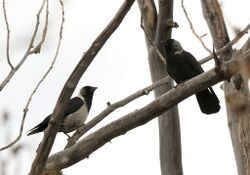Biology:Coloeus
| Coloeus | |
|---|---|

| |
| Left to right: Daurian jackdaw (Coloeus dauuricus) and Western jackdaw (C. monedula) | |
| Scientific classification | |
| Domain: | Eukaryota |
| Kingdom: | Animalia |
| Phylum: | Chordata |
| Class: | Aves |
| Order: | Passeriformes |
| Family: | Corvidae |
| Subfamily: | Corvinae |
| Genus: | Coloeus Kaup, 1829[1] |
| Species | |
Coloeus is a genus of bird that is sometimes treated as a subgenus of Corvus, including by the IUCN. It contains two relatively small species both named "jackdaws".[2] They have a blackish crown, wings and tail, the rest of the plumage being paler.[3] The word Coloeus is New Latin, from the Ancient Greek for jackdaws: Script error: The function "transl" does not exist. (κολοιός).[4][5]
Taxonomy
While some authors consider Coloeus a subgenus of Corvus, others have classified Coloeus as a distinct genus in the family Corvidae.[6] Following Birds of South Asia: The Ripley Guide,[7] the International Ornithological Congress has also reassigned the two jackdaw species from the genus Corvus to the genus Coloeus.[8]
Species
The species are the western jackdaw (Corvus monedula), which breeds in the British Isles and western Europe, Scandinavia, northern Asia and Northern Africa, and its eastern counterpart, the Daurian jackdaw (Corvus dauuricus), found from China and eastern Siberia to Japan .[3] The eastern species is smaller than the western jackdaw, and in the adult the pale areas of the plumage are almost white, whereas in the western bird these areas are pale grey. The iris is pale in western jackdaw and dark in Daurian jackdaw. The two species are otherwise very similar in shape, calls, and behaviour. There is an argument for lumping the subgenus members as one species, but they do not interbreed where their ranges meet in Mongolia.[3]
References
Citations
- ↑ Kaup, J. J. (1829). Skizzirte Entwickelungs-Geschichte und natürliches System der europäischen Thierwelt : Erster Theil welcher die Vogelsäugethiere und Vögel nebst Andeutung der Entstehung der letzteren aus Amphibien enthält. Darmstadt und Leipzig: Carl Wilhelm Leste. p. 114. https://archive.org/stream/skizzirteentwick01kaup#page/114/mode/2up/.
- ↑ Madge & Burn (1994) vii.
- ↑ 3.0 3.1 3.2 Madge & Burn (1994) 136-138.
- ↑ Cancik, Hubert; Schneider, Helmuth, eds (2006). "Crow". Brill's New Pauly. Brill. "the jackdaw (κολοιός/ Script error: The function "transl" does not exist., βωμωλόχος/ Script error: The function "transl" does not exist., Lat. monedula or graculus.)"
- ↑ Brown, R.W. (1954). Composition of Scientific Words: A Manual of Methods and a Lexicon of Materials for the Practice of Logotechnics. Smithsonian Institution Press. p. 219. https://archive.org/stream/compositionofsci00brow#page/219/mode/1up/search/jackdaw.
- ↑ Haring, E.; Gamauf, A.; Kryukov, A. (2007). "Phylogeographic patterns in widespread corvid birds". Molecular Phylogenetics and Evolution 45 (3): 840–862. doi:10.1016/j.ympev.2007.06.016. PMID 17920300.
- ↑ Rasmussen, Pamela C.; Anderton, John C. (2005). Birds of South Asia: The Ripley Guide. Lynx Edicions. ISBN 978-84-87334-67-2.
- ↑ Gill, F.; Donsker, D., eds. "Vireos, Crows & Allies". IOC World Bird List (version 2.8). http://www.worldbirdnames.org/n-vireos.html.
Works cited
- Madge, Steve; Burn, Hilary (1994). Crows and Jays: A Guide to the Crows, Jays and Magpies of the World. A & C Black. ISBN 0-7136-3999-7.
- Lewis, C.S (1955). The Magician's Nephew. The Bodley Head. ISBN 9780140301922.
Wikidata ☰ Q1234846 entry

